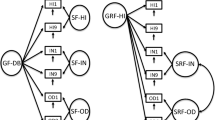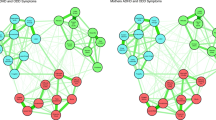Abstract
Parent ratings of ADHD and ODD symptoms depicted in written vignettes were examined for negative halo effects. Participants were 82 parents of children ages 6–12. Both unidirectional and bidirectional halo effects were found but to a lesser extent than in similar studies with teacher and college student raters. Specifically, parents were more likely to: (a) rate a child as inattentive in the presence of hyperactivity symptoms; (b) more likely to rate a child as oppositional in the presence of inattention and hyperactivity symptoms; and (c) more likely to rate a child as inattentive and hyperactive in the presence of oppositionality symptoms. Several specific symptoms were also found to be particularly susceptible to halo effects. Results suggest that parents may be more discerning raters of disruptive behavior disorders than teachers or college students and less prone to negative halo effects. Implications for clinical practice and future research directions are discussed.
Similar content being viewed by others
References
Abikoff, H., Courtney, M., Pelham, W. E., & Koplewicz, H. S. (1993). Teachers’ ratings of disruptive behaviors: the influence of halo effects. Journal of Abnormal Child Psychology, 21, 519–533. doi:10.1007/BF00916317.
Amador-Campos, J. A., Forns-Santacana, M., Guàrdia-Olmos, J., & Peró-Cebollero, M. (2006). DSM-IV attention deficit hyperactivity disorder symptoms: agreement between informants in prevalence and factor structure at different ages. Journal of Psychopathology and Behavioral Assessment, 28(1), 23–32. doi:10.1007/s10862-006-4538-x.
American Psychiatric Association (1994). Diagnostic and statistical manual of mental disorders (4th ed.). Washington, DC: American Psychiatric Association.
American Psychiatric Association (2000). Diagnostic and statistical manual of mental disorders (4th ed.-text revision). Washington, DC: American Psychiatric Association.
American Psychiatric Association (2013). Diagnostic and statistical manual of mental disorders (5th ed.). Washington, DC: American Psychiatric Association.
Antrop, I., Roeyers, H., Oosterlaan, J., & Van Oost, P. (2002). Agreement between parent and teacher ratings of disruptive behavior disorders in children with clinically diagnosed ADHD. Journal of Psychopathology and Behavioral Assessment, 24(1), 67–73. doi:10.1023/A:1014057325752.
Barkley, R. A., & Murphy, K. R. (1998). Attention-deficit/hyperactivity disorder: a clinical workbook (2nd ed.). New York: Guilford Press.
Barkley, R. A., & Murphy, K. R. (2006). Attention-deficit/hyperactivity disorder: a clinical workbook (3rd ed.). New York: Guilford Press.
Bauermeister, J. J., Matos, M., Reina, G., Salas, C. C., Martinez, J. V., Cumba, E., & Barkley, R. (2005). Comparison of the DSM-IV combined and inattentive types of ADHD in a school-based sample of Latino/Hispanic children. Journal of Child Psychology and Psychiatry, 46, 166–179.
Biederman, J., Newcorn, J., & Sprich, S. (1991). Comorbidity of attention-deficit/hyperactivity disorder with conduct, depressive, anxiety, and other disorders. American Journal of Psychiatry, 148, 564–577.
Center for Disease Control (CDC) (2011). Attention-deficit/hyperactivity disorder: Data and statistics. Retrieved from http://www.cdc.gov/ncbddd/adhd/data.html
Connor, D. F., & Doerfler, L. A. (2009). Attention-deficit/hyperactivity disorder and comorbid oppositional defiant disorder or conduct disorder. Current Attention Disorders Reports, 1, 5–11. doi:10.1007/s12618-009-0002-7.
Cohen, J. (1992). A power primer. Psychological Bulletin, 112, 155–159.
Connor, D. F., Steeber, J., & McBurnett, K. (2010). A review of attention-deficit/hyperactivity disorder complicated by symptoms of oppositional defiant disorder or conduct disorder. Journal of Developmental & Behavioral Pediatrics, 31, 427–440. doi:10.1097/DBP.0b013e3181e121bd.
Hartung, C. M., Van Pelt, J. C., Armendariz, M. L., & Knight, L. A. (2006). Biases in ratings of disruptive behavior in children: Effects of sex and negative halo effects. Journal of Attention Disorders, 9, 620–630. doi:10.1177/1087054705284233.
Hartung, C. M., Lefler, E. K., Tempel, A. B., Armendariz, M. L., Sigel, B. A., & Little, C. S. (2010). Halo effects in ratings of ADHD and ODD: Identification of susceptible symptoms. Journal of Psychopathology and Behavioral Assessment, 32, 128–137. doi:10.1007/s10862-009-9135-3.
Jackson, D., & King, A. (2004). Gender differences in the effects of oppositional behavior on teacher ratings of ADHD symptoms. Journal of Abnormal Child Psychology, 32, 215–224. doi:10.1023/B:JACP.0000019772.71251.ff.
Kuhne, M., Schachar, R., & Tannock, R. (1997). Impact of comorbid oppositional or conduct problems on attention-deficit hyperactivity disorder. Journal of the American Academy of Child & Adolescent Psychiatry, 36, 1715–1725. doi:10.1097/00004583-199712000-00020.
Murray, D. W., Kollins, S. H., Hardy, K. K., Abikoff, H. B., Swanson, J. M., Cunningham, C., et al. (2007). Parent versus teacher ratings of attention-deficit/hyperactivity disorder symptoms in the preschoolers with attention-deficit/hyperactivity disorder treatment study (PATS). Journal of Child and Adolescent Psychopharmacology, 17, 605–619. doi:10.1007/s10567-015-0178-6.
Narad, M. E., Garner, A. A., Peugh, J. L., Tamm, L., Antonini, T. N., Kingery, K. M., Simon, J. O., & Epstein, J. N. (2015). Parent–teacher agreement on ADHD symptoms across development. Psychological Assessment., 27. doi:10.1037/a0037864.
Pliska, S. R. (2011). Treating ADHD and comorbid disorders: psychosocial and Psychopharmological interventions. New York, NY: Guilford Press.
Schachar, R., Sandberg, S., & Rutter, M. (1986). Agreement between teachers’ ratings and observations of hyperactivity, inattentiveness, and defiance. Journal of Abnormal Child Psychology, 14, 331–345. doi:10.1007/BF00915450.
Semrud-Clikeman, M., & Ellison, A. T. (2009). Child neuropsychology: assessment and interventions for neurodevelopmental disorders (2nd ed.). New York, NY: Springer Science.
Sheskin, D. J. (2007). Handbook of parametric and non-parametric statistical procedures (4th ed.). Boca Raton, FL: Chapman & Hall/CRC.
Smith, B. H., Barkley, R. A., & Shapiro, C. J. (2009). Attention-deficit/hyperactivity disorder. In E. J. Mash & R. A. Barkley (Eds.), Assessment of childhood disorders- (Fourth ed., pp. 53–123). New York, NY: Guilford Press.
Sollie, H., Larsson, B., & Morch, W. T. (2013). Comparison of mother, father, and teacher reports of ADHD core symptoms in a sample of child psychiatric outpatients. Journal of Attention Disorders, 17, 699–710. doi:10.1177/1087054711436010.
Stefanatos, G. A., & Baron, I. S. (2007). Attention-deficit/hyperactivity disorder: a neuropsychological perspective towards DSM-V. Neuropsychology Review, 17, 5–38. doi:10.1007/s11065-007-9020-3.
Stevens, J., Quittner, A. L., & Abikoff, H. (1998). Factors influencing elementary school teachers’ ratings of ADHD and ODD behaviors. Journal of Clinical Child Psychology, 27, 406–414. doi:10.1207/s15374424jccp2704_4.
Tripp, G., Schaughency, E., & Clarke, B. (2006). Parent and teacher rating scales in the evaluation of attention-deficit hyperactivity disorder: contribution to diagnosis and differential diagnosis in clinically referred children. Journal of Developmental & Behavioral Pediatrics, 27, 209–218. doi:10.1097/00004703-200606000-00006.
Wolraich, M., Lambert, E., Bickman, L., Simmons, T., Doffing, M., & Worley, K. (2004). Assessing the impact of parent and teacher agreement on diagnosing Attention-Deficit Hyperactivity Disorder. Developmental and Behavioral Pediatrics, 25, 41–47. doi:10.1097/00004703-200402000-00007.
Author information
Authors and Affiliations
Corresponding author
Ethics declarations
Funding
This study was not funded by any external agencies.
Informed Consent
Informed consent was obtained from all study participants.
Conflicts of Interest
Lindsey N. DeVries, Cynthia M. Hartung and Tara L. Golden declare that there is no conflict of interest.
Experiment Participants
All procedures performed in studies involving human participation were in accordance with the ethical standards of the institutional research committee.
Appendix A
Appendix A
Sample Vignette (ADHD-CT)
Crystal is an 8-year-old girl in the 3rd grade. She is fascinated by horses and loves to be outside. Crystal began having problems in school in Kindergarten. Her current teacher frequently complains about Crystal’s difficulty staying seated and focusing on her work. During 1st and 2nd grade Crystal’s teachers complained about her failure to get work done and difficulty sitting still.
Crystal’s parents report that she has been “on the go” since she was a young child. At home she likes to play outside and play on her swing set. Going out for dinner is frustrating because Crystal has difficulty staying seated and waiting for her food. Even meals at home are unpleasant because Crystal is constantly fidgeting which causes frequent spills. Some children don’t like to play with Crystal because she has difficulty taking turns.
When redirected, Crystal initially complies but only for a short time. Crystal’s parents are also concerned about her short attention span, specifically her inability to stay occupied with an activity for more than a few minutes. Additionally, Crystal often does not follow through with instructions at home.
At school, her favorite subjects are science and music. Crystal’s teacher reports that she often gets out of her seat to look out the window because something has distracted her. Even when she stays seated, she is often not working on her assignment and is talking to other children who are trying to work. Any noise, even another child coughing or dropping a pencil, distracts Crystal from her work. Her teacher also reports that she often loses things in school such as leaving her coat on the playground. In addition, when her teacher speaks to her, Crystal often does not seem to hear her unless she repeats herself or raises her voice.
Rights and permissions
About this article
Cite this article
DeVries, L.N., Hartung, C.M. & Golden, T.L. Negative Halo Effects in Parent Ratings of ADHD and ODD. J Psychopathol Behav Assess 39, 179–188 (2017). https://doi.org/10.1007/s10862-016-9560-z
Published:
Issue Date:
DOI: https://doi.org/10.1007/s10862-016-9560-z




